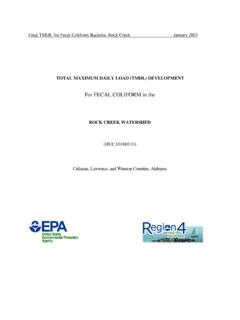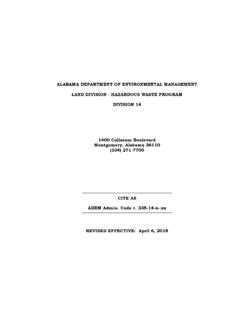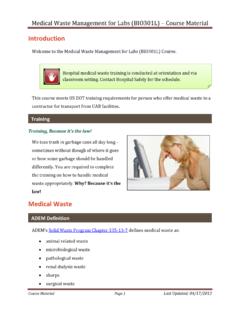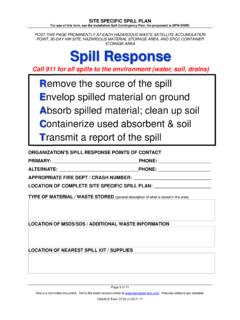Transcription of Hazardous Waste Management - Alabama …
1 Alabama department of environmental Management land division P. O. Box 301463 Montgomery, AL 36130-1463 Telephone 334-271-7730 Fax 334-279-3050 May 2018 Hazardous Waste Management The Small Quantity Generator Information presented in this fact sheet is intended to provide a general understanding of the regulatory requirements governing small quantity generators of Hazardous Waste . This information is not intended to replace, limit, or expand upon the complete regulatory requirements found in division 14 of the ADEM Administrative Code. WHAT IS A SMALL QUANTITY GENERATOR? Generators of Hazardous Waste are divided into three categories based upon the quantity of Hazardous Waste generated.
2 See ADEM's fact sheet, Hazardous Waste : The Basics, for additional general information regarding generators of Hazardous Waste . If you produce more than 220 pounds, but less than 2,200 pounds, of Hazardous Waste and no more than pounds of acute Hazardous Waste in a calendar month, you are a Small Quantity Generator (SQG) for that month. The requirements that apply to you as a SQG are found in ADEM Admin. Code ch. 335-14-3 and, by reference, parts of ADEM Admin. Code ch. 335-14-6. WHAT IS A Hazardous Waste DETERMINATION? You are required to determine whether the Waste you generate is Hazardous Waste . For details on how to make this determination, refer to ADEM Admin.
3 Code r. (2), as well as ADEM's fact sheet, Hazardous Waste Determination. SHOULD I HAVE AN EPA IDENTIFICATION NUMBER? If you are an SQG, you must notify the department and request an EPA Identification Number using ADEM Form 8700-12, Notification of Regulated Waste Activity. You will be required to submit an annual re-notification using the same form. Consult the specified month schedule found at ADEM Admin. Code r. (1)(a) to determine when your annual notifications are due. WHAT IS SATELLITE ACCUMULATION? You may accumulate small quantities of Waste (up to 55 gallons of Hazardous Waste and/or either one quart of liquid acute Hazardous Waste or pounds of solid acute Hazardous Waste ) in containers at or near any point where Waste is initially generated.
4 These "satellite" containers must be in good condition, made of or lined with materials that are compatible with the Waste , kept closed except when adding or removing Waste , and marked with the words " Hazardous Waste " and an indication of the hazards of the contents (see the ADEM fact sheet, Satellite Accumulation Fact Sheet, for additional information). Ensure all satellite accumulation areas are included in your emergency and contingency planning. WHAT ARE MY TIME AND QUANTITY ACCUMULATION LIMITS? You may accumulate Hazardous Waste on-site for up to 180 days without a permit or without having interim status.
5 This time limit is extended to 270 days if your Waste must be transported 200 miles or more for off-site treatment, storage, or disposal. Both the 180-day and 270-day limits may be extended up to 30 days due to unforeseen, temporary, and uncontrollable circumstances, at the discretion of ADEM on a case-by-case basis. In any event, the total quantity of Hazardous Waste accumulating on-site must never exceed 13,200 pounds of Hazardous Waste or pounds of acute Hazardous Waste . IN WHAT KINDS OF UNITS MAY I ACCUMULATE Hazardous Waste ? You may accumulate your Hazardous Waste in containers, tanks, containment buildings, or on drip pads.
6 If you accumulate Hazardous Waste on drip pads or in containment buildings, refer to ADEM Admin. Code rs. and for specific requirements regarding these specialized units. CONTAINER REQUIREMENTS Use containers that are in good condition. Mark each container with the accumulation start date. Keep containers closed, except when adding or removing Waste . Handle and store containers in a manner that will prevent leaks. Label each container with the words " Hazardous Waste ", an indication of the hazards of the contents, and the appropriate EPA Hazardous Waste number(s). Place only Waste that is compatible with the previous contents in an unwashed container.
7 Inspect the area where containers are stored, at least weekly, looking for leaks or deterioration. Use containers that are made of or lined with materials that are compatible with the Waste . Place only compatible materials in the same container. Stack containers larger than 30-gallon capacity no more than two high. Separate containers of incompatible Waste and materials by means of a dike, berm, wall, or other device. TIP If your generator category changes from month to month, you should notify as the larger category and follow all applicable requirements of the larger category to ensure you are always in compliance.
8 TIP 26 gallons (about half of a 55-gallon drum) of Hazardous Waste with a density similar to water weighs about 220 pounds. The Small Quantity Generator Page 2 of 3 TANK REQUIREMENTS Label each tank with the words " Hazardous Waste ", an indication of the hazards of the contents, and the appropriate EPA Hazardous Waste number(s). Accumulate only Waste that will not cause the tank or inner liner to rupture, leak, corrode, or otherwise fail. Inspect, at least daily, discharge control equipment, monitoring equipment data, and Waste levels (uncovered tanks). Inspect, at least weekly, construction materials of the tank and discharge confinement structures looking for corrosion, erosion, or leaks.
9 Accumulate Hazardous Waste in a way that avoids the potential to produce extreme heat or pressure, fire or explosion, or violent reaction, uncontrolled toxic or flammable mists, fumes, dusts, or gases, damage to the structural integrity of the tank, or other threats to human health or the environment. Comply with the buffer zone requirements of the National Fire Protection Association for ignitable or reactive Waste . Protect ignitable or reactive Waste from any material or conditions that may cause the Waste to ignite or react. Maintain at least 2 feet of freeboard in uncovered tanks. Place only compatible materials in the same tank.
10 Place only Waste that is compatible with the previous contents in an unwashed tank. Equip continuously-fed tanks with a means to stop the inflow. Be able to document that each tank is emptied within 180 days. Remove all Hazardous Waste from tanks, discharge control equipment, and discharge confinement structures upon closure. HOW SHOULD I PREPARE FOR EMERGENCIES? If you accumulate Hazardous Waste on-site, you must operate in a way that minimizes the possibility of fire, explosion, or any unpermitted release of Hazardous constituents to the environment. Also, you must be prepared to take appropriate actions in response to emergency situations at your site.








